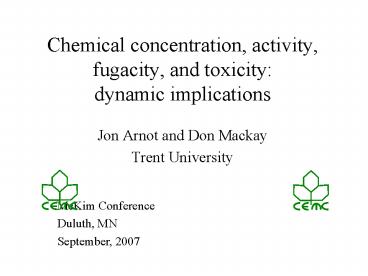Chemical concentration, activity, fugacity, and toxicity: dynamic implications - PowerPoint PPT Presentation
1 / 26
Title:
Chemical concentration, activity, fugacity, and toxicity: dynamic implications
Description:
Chemical concentration, activity, fugacity, and toxicity: dynamic implications ... Fecal egestion; kE. Metabolic biotransformation; kM. Growth dilution; kG ... – PowerPoint PPT presentation
Number of Views:149
Avg rating:3.0/5.0
Title: Chemical concentration, activity, fugacity, and toxicity: dynamic implications
1
Chemical concentration, activity, fugacity, and
toxicitydynamic implications
- Jon Arnot and Don Mackay
- Trent University
McKim Conference Duluth, MN September, 2007
2
Overview
- Building on Part I by Don Mackay
- Four chemicals, log KOW 2, 4, 6, 8
- Two organisms, fish and mammal
- Objectives
- Reference point for acute baseline toxicity
(narcosis) - Data quality
- Assumptions vs reality
- Dynamic profiles and complicating factors
(biotransformation rates, absorption efficiency) - Internal vs external concentrations and activities
3
Reference point for hazard identification
- Lethality is well defined
- Toxic Ratio (TR) or excess toxicity
CBRX (mmol.kg-1) / CBRN (mmol.kg-1) - If CBRN 3 mmol.kg-1 and TR gt 10 then chemical
x has greater potency
4
Equilibrium partitioning (EqP)
EqP activity in exposure medium activity in
organism
Complete bioavailability No biotransformation or
growth dilution
5
Series of toxicity experiments
- Illustrations using a kinetic mass balance model
- Fish
- Mammal
- Exposure concentrations based on EqP assumptions
to exert a toxic effect at 3 mmol.kg-1 or 3
mol.m-3 whole body concentration, i.e., narcosis - Four chemicals, each with three different
metabolic biotransformation rates (0, 0.1, 1.0
d-1)
6
Two organisms same properties and processes
(air vs water)
NLOM equivalent to 3.5 lipid
(both 100 g)
7
Model
steady state
8
Equilibrium partitioning fish
Chemical
A B C D
Log Kow 2 4 6 8
Concn in fish mol/m3 or mmol/kg 3 3 3 3
BCF (fish/water) 1.14E01 1.07E03 1.07E05 1.07E07
Concn in water mol/m3 2.63E-01 2.80E-03 2.80E-05 2.80E-07
Concn in water g/m3 2.63E01 4.20E-01 5.61E-03 7.01E-05
Activity in water and fish 0.033 0.042 0.056 0.070
9
Chemical A
Cwater 0.263 mol.m-3
activity in fish ? activity in water ? 0.03
No big difference!
short
10
Chemical B
Cwater 0.0028 mol.m-3 awater 0.04
substantial differences in activity and tsteady
state
11
Chemical B
Cwater 0.0028 mol.m-3 awater 0.04
substantial differences in activity and tsteady
state
Need to increase Cwater !!
activity in fish ? activity in water!!
Factor of 5 awater 0.2
12
Chemical C
Cwater 0.028 mmol.m-3 awater 0.056
big differences in activity and tsteady state
13
Chemical C
Cwater 0.028 mmol.m-3 awater 0.056
big differences in activity and tsteady state
Need to increase Cwater !! BUT, exceed water
solubility limits i.e., awater gt 1
X
14
Chemical D
CSS Cwater 0.074 µmol.m-3 awater 0.07
huge differences in activity and tsteady state
15
Chemical D
CSS Cwater 0.074 µmol.m-3 awater 0.07
huge differences in activity and tsteady state
No chance!
16
Equilibrium partitioning mammal
Chemical
A B C D
Log Kow 2 4 6 8
Concn in mammal mol/m3 or mmol/kg 3 3 3 3
BCF (mammal/air) 1.26E03 1.77E05 2.65E07 3.53E09
Concn in air mol/m3 2.39E-03 1.70E-05 1.13E-07 8.49E-10
Concn in air g/m3 2.39E-01 2.54E-03 2.26E-05 2.12E-07
Activity in air and mammal 0.033 0.042 0.056 0.070
17
Chemical A
Lower concentrations in air compared to water
minor differences
18
Chemical B
Cair 0.017 mmol.m-3 aair 0.04
19
Chemical B
Cair 0.017 mmol.m-3 aair 0.04
Maximum activity in mammal ? activity in air!!
Need to increase Cair !! BUT, exceed air
solubility limits, i.e., vapor pressure
20
Chemical C
Cair 0.11 ?mol.m-3 aair 0.056
same story
560x
5,600x
56,000x
21
Chemical D
PSS Cair 0.22 nmol.m-3 aair 0.07
same story
22
A view to a kill (96 h LD50)
Chemical C fed 2x/d
kM
Organism Parameter Units 0 d-1 0.1 d-1 1 d-1
Fish CD (mg/kg) 165,000 200,000 580,000
Fish t99 (d) 294 40 4.5
Mammal CD (mg/kg) 102,000 124,000 360,000
Mammal t99 (d) 436 42 4.6
Inhalation exposure is assumed irrelevant
not at steady state or equilibrium!
BMFs are larger in the mammal
23
A view to a kill (96 h lethal dose)
Chemical C but 0.5 ED
kM
Organism Parameter Units 0 d-1 0.1 d-1 1 d-1
Fish CD (mg/kg) 330,000 400,000 X
Fish t99 (d) 294 40 4.5
Mammal CD (mg/kg) 204,000 248,000 720,000
Mammal t99 (d) 436 42 4.6
Have to double the dose!
24
Summary
- Uptake times can be long and can exceed standard
test durations, combined exposure routes may be
necessary - Exposure concentrations and activities rarely
approximate internal concentrations and
activities - Metabolites that may be toxic will further
complicate interpretation of toxicity
measurements - Need to measure both internal and external
concentrations to identify more potent chemical - Need for a quality toxicity dataset
- Uncertain data result in uncertain models
25
Ferguson 1939
- Careful inspection of the toxicity data can
support Fergusons proposal that activity be used
to interpret toxicity data such that the
disturbing effect of phase distribution is
eliminated from the comparison of toxicities
26
- Thank you!































